If you’ve been riding on a twintip for a while, learning to kitesurf on a directional board is both an exciting and challenging new step that can take your kiteboarding to a new level. Although directional kiteboards/surfboards are primarily designed for riding in waves, directional kitesurfing in flat water can be an awesome experience.
Switching from a twintip to a directional board isn’t easy at first, as the position and stance are quite different. For some kiteboarders getting started on a kitesurf board may feel like starting over from scratch.
In this post, I’ll share 14 important tips based on my own experience learning to kitesurf on a directional. I hope these tips will help you quickly through the initial common hurdles and get you riding a surfboard with a kite faster.
Table of Contents
Tip #1: get yourself a big, wide, flat board
To get started on a directional board, your best bet is to start on a big, wide, high volume board with a flat rocker – such as the North Nugget or the Waiman Gambler. These boards are normally shaped for light wind – they have good bottom end wind range and flatwater conditions.
You’ll find such a board much easier to learn to get up, switch feet, and jibe on than a regular shape surfboard. Once you master the waterstart and upwind riding, you’ll still be able to use the board on low wind days and for having fun in small and mushy waves under 3-4 feet.
Get a board with a relatively wide tail and little rocker (flatter shape) for stability, and the ability to be set up with 4 fins (“quatro”) for light winds.
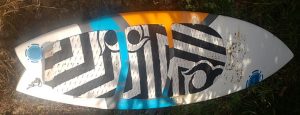
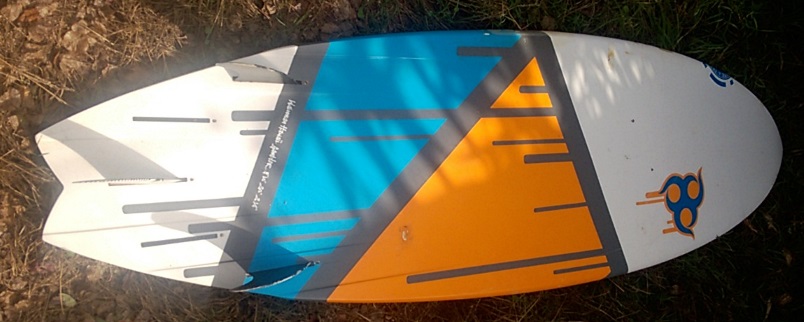
With regard to board material composition, you can get started on pretty much any kind of board, e.g. a used regular surfboard. Just be aware though, that regular surfboards used in kiteboarding quickly give in from foot pressure, particularly when learning (flawed stance).
You may be better off looking for a used kite-specific directional board to start with as these have extra layers for strengthening. Alternatively, you may pick up a cheap surf specific board and add extra layers of glassing on it.
Tip #2: Start in a flatwater spot
If you want to learn faster, start in flat water, as flat as you can – e.g. on a pond or a lake. Choppy water and small waves really get in your way when learning the waterstart on a directional kiteboard.
I live near the ocean, but when I first started learning directional kiting, I would always drive to a lagoon 2 hours away from home just to speed up my learning curve. And it worked!
Chances are the water may not be completely flat if there’s decent wind, unless there’s some natural or man-made obstacle shielding it from the wind without affecting wind speed in your kite.
Some small chop is OK though, even though your big board will likely have a lot of buoyancy and will easily get tilted from the chop. Once you have your waterstart down, you can move on to choppier water to acquire more skills.
If you can, try to pick a spot with a wind direction such that you’ll be doing your waterstart in your natural stance – this can help you a lot. For example, if you’re a natural regular footer (left foot forward) things will be much easier if the wind blows from your left side when you’re facing the water.
Of course, that’s not always possible and you’ll still learn the waterstart in your switch stance – it just might take you a bit more effort.
Tip #3: Pick a smaller kite size than usual
If you have a big board for learning, make sure to use a kite 2-3m2 smaller than you would use with a twintip. Most riders who kitesurf on a directional board ride with too much kite and often overpowered.
Due to the added surface and buoyancy of directional boards – particularly light wind/beginner boards, it takes much less kite power to get them going. An experienced directional, 75kg rider can typically ride strapless on a 6 or 7m kite in as little as 14-15 knots.
Remember, you need power to get a twintip to float and slide on the water while you stand on it. A high-volume surfboard, meanwhile, can probably lift you (or nearly so) even when still. As a result, too much kite will give too much power and pull you overboard.
Note that riders who use straps on a directional kiteboard are able to get away with too much kite power since their feet stay attached to the surfboard even when pulled hard. However, this defeats the purpose of directional board kitesurfing, which is surf style and wave riding.
Tip #4: Use a single strap and set it loose
When switching over from a twin tip kiteboard to a directional board, most riders initially feel more confident using straps. Unlike for twintips, however, straps are not required on a surfboard due to its larger size and buoyancy (see later section for more on straps).
Where straps come in handy for learning directional kiting is in the waterstart. Using a front strap locks your front foot in like on a twintip, making it easier for you to lift yourself up with the kite’s pull and stand on the board. A front strap also helps you get into a stable position before diving the kite.
You should keep your front strap loose so you can rotate your front foot relatively freely. You should avoid using the rear strap when learning as it will get in the way of finding the right stance, both during and following the waterstart.
Tip #5: Get in the right position for waterstart
The hardest part of the waterstart with a directional kiteboard is getting into the right position before getting up. Your buoyant board sits afloat on top of the water, you’re sitting in the water with both your feet on top of the board, front foot in the strap – a rather uncomfortable position.
The board tends to drift downwind as you try to get the kite ready, with your feet sometimes slipping off the board – such that you need to start all over again. The following are some helpful tips:
- Slide only your front toes into the strap, not all the way to your ankles, so as to keep your heels on your board’s rail.
- Shift your kite slightly back and forth around the 12:00 position to create a slight lift, helping you remain stable in the water with your feet in position on top of the board.
- Point the board downwind with your feet, steering it with the front strap.
- Dive the kite in the window while pushing with your heels on the rail to get yourself up
Tip #6: Start with the board flat then dig in
As you take off on your directional kitesurf board, you’re riding downwind with your board flat on the water. If you stay in this position (if the wind is relatively strong) you will quickly start going too fast and you may lose control.
So just like on a twintip, as soon as you gain more speed you start to gradually turn your board upwind. On a directional, you do that by putting more weight onto your front foot and digging the rail with both your heels.
Be sure to position your heels close to the rail for leverage – again don’t push your front foot too deep into the strap to keep it in contact with the rail.
Tip #7: Get into the right stance for upwind
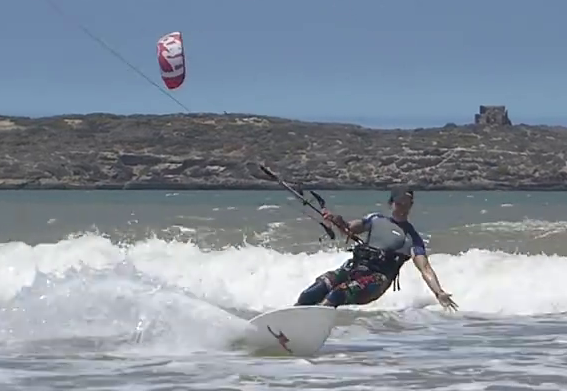
Again, on a directional board, most of your weight should be in your front foot, unlike on a twintip where your weight mainly lies in your back foot to avoid face planting.
Place your back foot in front of where your rear strap would normally be – if you followed the previous tips you shouldn’t have a rear strap on. Your back foot’s heel should be pressing hard onto the rail just like your front foot.
At the same time, you rotate your hips and shoulders from a sideways facing position to forward facing. Thus, your shoulders and hips are no longer aligned with your feet.
Your front foot also rotates a bit externally, as much as it can within the loose strap toward your riding direction. Your body rotation, combined with shifting your weight onto your front leg and digging the rails with your heels, will make your surfboard edge upwind very efficiently.
Tip #8: Learn to body drag with your surfboard
Riders who are learning directional board kitesurfing often think body dragging with a surfboard is impossible.
Directional boards are quite bulky and don’t have a handle for grabbing. If you have a front strap set up, however, you can often use it as a handle when body dragging upwind.
Even without any straps on, a surfboard is actually quite easy to body drag with once you get the hang of it. You can use the board’s fins to body drag very efficiently. While powering your kite slightly with one hand, rest your other arm on top of your floating board.
With your hand on top push your board perpendicular to your kite lines, pressing down on the rail to make the board edge upwind. The board’s fins will make your board slide upwind, pulling you along.
You’ll be surprised how well you can body drag upwind using this simple technique.
Tip #9: Get comfortable riding in both directions
Most beginner directional kitesurfers agree the hardest part of kitesurfing with a surfboard is changing direction. Before you tackle this challenge, you should first get fully comfortable riding in both directions on your directional board.
You can’t go in the reverse direction without switching feet, so at first, don’t worry about turning. Once you’re ready to turn around and ride back towards the shore, just jump off your board, turn it around with your hand, and do a waterstart in the reverse direction.
You need to master getting up in the reverse stance – which may be your natural or switch stance depending on wind direction. Again, don’t forget to stabilize your kite while sitting in the water before diving it, and to put your weight on your front leg after the kite pulls you up.
Tip #10: Leverage your natural stance to learn jibing
As mentioned, changing direction is often the part of learning to kitesurf on a surfboard that requires the most time and practice.
The jibing maneuver involves switching feet, going from your natural stance to your switch stance or vice-versa, while at the same time turning your kite to the opposite half-window.
To perform the jibe, you:
- Take your feet out of the straps
- You drag your back foot up near your front foot around the middle of your board
- You move your front foot to the back and rotate both your feet back into surf stance
Now here’s my key tip: when jibing I try to stay in my natural stance (left foot forward) as long as possible. So, if I’m riding into the turn with my left foot forward when facing the kite, I’ll first turn my kite and board around before I switch feet. This means I’m riding toeside for a short lapse after the turn.
Conversely, when I’m coming into the turn with my right foot forward facing my kite, i.e. in my non-natural stance, I’ll switch feet before turning, riding toeside, with my back to the kite. As a result, as I complete the turn I’m already in my natural stance, left foot forward facing the kite.
A challenge of jibing is to maintain some speed while switching feet and turning the kite. A directional board with extra volume will help you achieve this. For more details about performing a jibe, check out this article.
Tip #11: learn to ride through whitewater
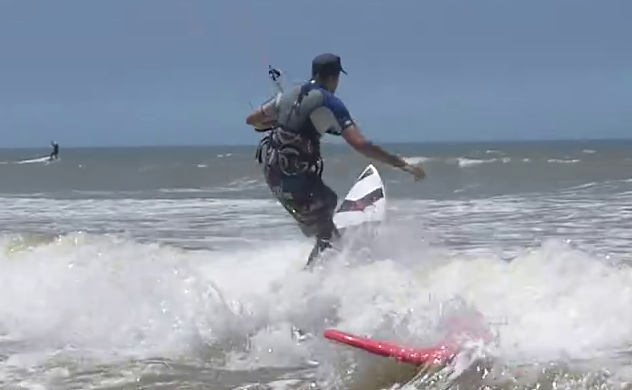
Going over waves when riding out on a directional board is another skill you need to learn. How challenging this is depends on:
- Whether there are mostly unbroken, green waves or mainly whitewater
- Whether you’re riding strapped or strapless
Whitewater is generally the trickiest to get past. If strapped, most beginners will just slam their board onto the wave to go over it, that’s what I used to do as well before learning how to do it right. This approach results in hard impacts on your knees and joints as well as on your board.
When riding strapless, you have no choice but to learn going over waves in a softer and subtler fashion, as the smashing approach will typically throw you off the board. Here are my tips:
- Before you reach the incoming wave, edge upwind hard to reduce speed. You don’t want to run into the wave head-on at high speed.
- Right before you hit the wave, steer your board downwind. Hitting the wave while edging upwind would result in a strong impact.
- Right before hitting the wave, put your weight on your back foot to raise the nose of your board slightly. at the same time, bring your kite up to 12:00 and pull the bar slightly to create a small lift upward, de-weighting for climbing over the wave.
- As you hit the wave, your board slides over the white water thanks to the raised nose and the uplift from your kite. Once above it, immediately shift your weight up onto your front foot, and lower your kite back down from 12:00 to 10:00 (or 2:00) – i.e. you hit the gas pedal.
It’s taken me a lot of time, hard impacts, board losing and even kite dropping before I figured this out. Now, however, this technique works like a charm and I’m able to go over pretty big whitewater waves when riding strapless – the same technique applies to strapped riding.
Tip #12: Lose the straps
Speaking of strapped vs strapless, beginner directional board kitesurfers often ask which of the two is better. There’s no clear-cut answer to this question as it’s a matter of riding style, i.e. twintip-style vs surf-style riding. The following are some pros and cons of each:
Strapped riding:
| Straps are helpful for ... | Straps make it harder to ... |
|---|---|
| Learning the waterstart (front strap) | Jibe: need to pull feet out before, and tuck them back in after |
| Passing / going over waves (front strap) | Edge upwind super efficiently: can't rotate your hips and torso and freely move feet |
| Riding overpowered | Change positions freely. E.g. go ride upwind -> turn -> ride the wave -> turn again etc |
| Do jumps like on a twintip (both straps) | Make progress in surfboard-style and wave riding |
| Learn to carve on waves without falling | Avoid ankle injuries - e.g. if one foot stays in the strap while the board gets twisted |
Strapless riding:
| Strapless makes it easier to ... | Strapless make it harder to ... |
|---|---|
| Jibe, ride upwind | Do the waterstart, especially when far at sea (for beginners) |
| Change positions, find the board's sweet spot for each maneuver | Stay on the board in chop (for beginners) |
| Freeride waves like on a surfboard - doing smooth carves, bottom & top turns | Ride fast with the board flat on water |
| Go over whitewater and bigger waves | |
| Jump - strapless airs are very technical and require a lot of skills | |
| Ride overpowered |
When riding strapless in chop and strong wind, the key is to always keep both your heels on the rail vs on the flat of your board and to maintain strong pressure under your feet by continuously digging the rail.
By constantly pushing into the edge of your board with your feet, you keep the board under your soles even in the shakiest conditions.
Most directional riders will agree strapless riding gives you the ultimate feeling of surf carving and freedom. You develop an instinct for where your feet should be at any time and how much weight to put on each leg.
With time you become a much more nimble and reactive rider, and your start relying less and less on your kite’s power and more on the wave for your riding.
Tip #13: Learn toeside riding
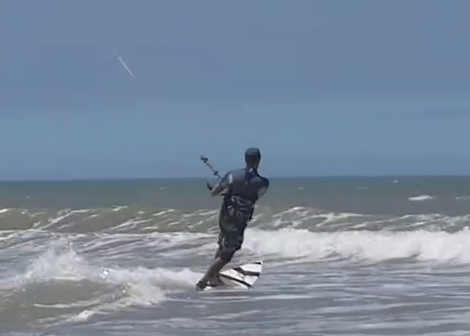
Besides waterstart and jibe, one of the keys to becoming a directional board kitesurfer is riding toeside smoothly and comfortably.
Toeside means your weight is on your toes vs your heels, and you’re digging your toeside rail (vs heelside rail) by pressing with your toes and ball of your feet. In toeside position, you’re riding with your kite behind your back (vs facing it).
Getting toeside is easy if you know how to jibe, all you do is switch feet without changing direction. When riding heelside, you typically lean back and dig your heels in. When toeside, you lean forward and dig your toes in, with your kite lines on your side and out toward the back.
Toeside riding is essential in directional kiteboarding because it allows you to quickly change direction without switching feet. Having to jibe over and over again with each turn would seriously limit your carving ability. Being comfortable toeside, you can stay in your natural stance through successive carves e.g. on a wave.
Toeside is what allows me to ride waves like on a surfboard. It took me a bit of time to develop the muscle memory for toeside riding. I actually found it easier to learn it on a twintip before moving to a directional.
The trick is to really lean forward hard to maintain a strong tension in your lines (which go out to your back). With practice, you’ll be able to ride upwind in toeside stance – although probably not as efficiently as heelside.
Toeside riding will initially be hard on your back leg hamstring, calf muscles, and hip flexors. At first, you’ll be sore following a toeside session. Eventually though, these muscles will build up.
Tip #14: Switch to a smaller board
After learning to waterstart, ride upwind, jibe and ride toeside comfortably, the next step for you as a directional kitesurfer will be learning to surf waves. For this, you’ll eventually need a smaller board, small enough that you can go rail to rail without changing your front foot’s position on the board.
A smaller board typically will have more rocker, allowing it to perform well in bigger, hollower waves. It will have less buoyancy than your beginner board, so you’ll need more kite power to ride it.
A small board will be more sensitive to wind lulls as it needs more power to float – it will start sinking when your kite stalls. Jibing will also be harder on a narrower board, being much less stable when moving your feet around.
In short, riding a smaller board requires more skills and experience. But that should probably be one of your end goals as it will allow you to reap the full potential and freedom of the surfing experience in kiteboarding.


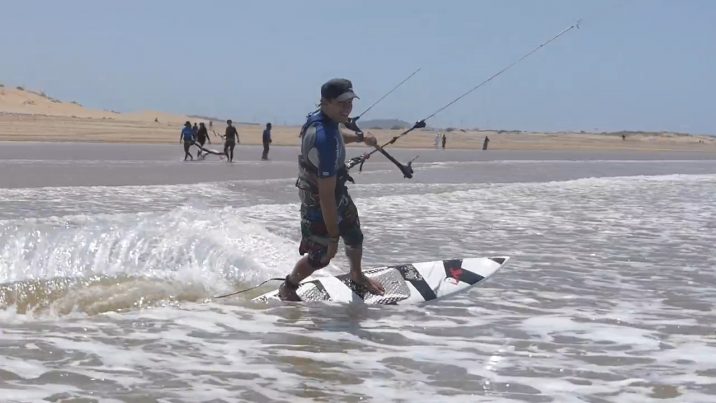
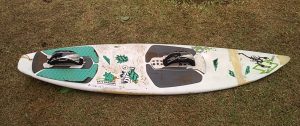
Intelligent, well-written advice from a writer/kiter who has the necessary good recall of the harrowing experience of being a beginner. Not as common as it could be…
Cheers,
Rob
Thanks Rob, greatly appreciate the feedback! Jesse
Really helpful overview and tips Jesse, thanks! Starting to learn directional, this really helped.
Jesse, I started out on a 5ft11″ quite thick (about 2″) beginner board as you advise. My weight is 72kg, would would you advise when switching to something smaller?
Hey Daniel, sorry I didn’t get your question, can you clarify?
Glad you found it useful Daniel! Ride on!
Sure! I’ve started out on a 5ft11″ quite thick (about 2.5″) beginner board as you advise (rental equipment). My weight is 72kg. I’m now comfortable waterstarting both sides and have managed a few transitions in both directions. I’m really stoked waveriding and would like to continue. Do you advise switching to a smaller (shorter, narrower, thinner) board or not? And where kites are concerned, I now ride Core XR5 on my twntip, so considering the Core Section or Nexus. Any experience with those kites?
Hi Daniel, if you’re comfortable jibing both ways on your thicker board, your next step will probably to learn to surf the wave and make bottom and top turns in it. A thinner board will turn better in the wave than a bigger lightwind board. The trick is to have the right volume for a given wind and kite though. Thinner board with low wind means bigger kite, but smaller kites tend to turn faster than bigger ones. Of course it also depends if you’re kiting in onshore or side/offshore conditions – in the latter case you don’t turn the kite as much, you tend to just park and ride. So as you can see there are a lot factors at play. My favorite kite surfboard is a 5″11 Resin8 which is quite thick but not so narrow, works well for medium wind and medium waves. When I get out in high wind and bigger waves, tough, a narrower board cuts through the water better. What kind of wind and waves conditions do you ride in?
Sorry I haven’t tested the Core Section or Nexus yet.
Thanks for all the details Jesse. I’ll typically be riding 75cm-160cm waves (about 2′ to 6′) in wind between 15kts and 30kts, usually around 20kts though.
I was looking at a Naish Global wave board, 5’10″x18″x2″3/16. Kites would be my Core free 7m (when wind is above 20kts) and looking for a 9m2 for the 13-20kts range. Make sense?
Hey Daniel, the Naish Global looks great, wide enough for riding smaller waves comfortably yet with thin enough rails to hold the lines in more hollow surf. 5″10 sounds like a good size for you, you could go slightly shorter but with the greater board volume of the 5″10 you may eventually be able to ride a smaller kite (e.g. 5-6m) in winds above 20 knots, which is great for wave slashing.
I’m looking at getting into SB and this site is the best. well explained of all aspects!
What level do you think a TT kiter should have before moving to SB?
Thanks so much.
Hey, if you know how to ride upwind on a TT you can definitely start learning on a surfboard. Just start on flat with good steady wind so you can focus on placing your feet right. Starting with straps – at least one (front) – will also help. The main difference between a strapped SB and a TT is when changing direction (jibe), using only the front strap on a SB will help you learn faster since you won’t need to pull your back feet out of the strap before turning. Ride on!
Thank you!
Do you recommend using a board leash when first starting out (or ever)?
Very profound explanations! Tells all the pro´s and con´s of strapless vs. strap.
If starting on flat with no current, and assuming you know how to do the body drag, you should start without a leash. In waves though a leash helps a lot, unless the wind is so strong that there’s a risk your board will whip back and hit you – you should probably avoid such conditions to start with.